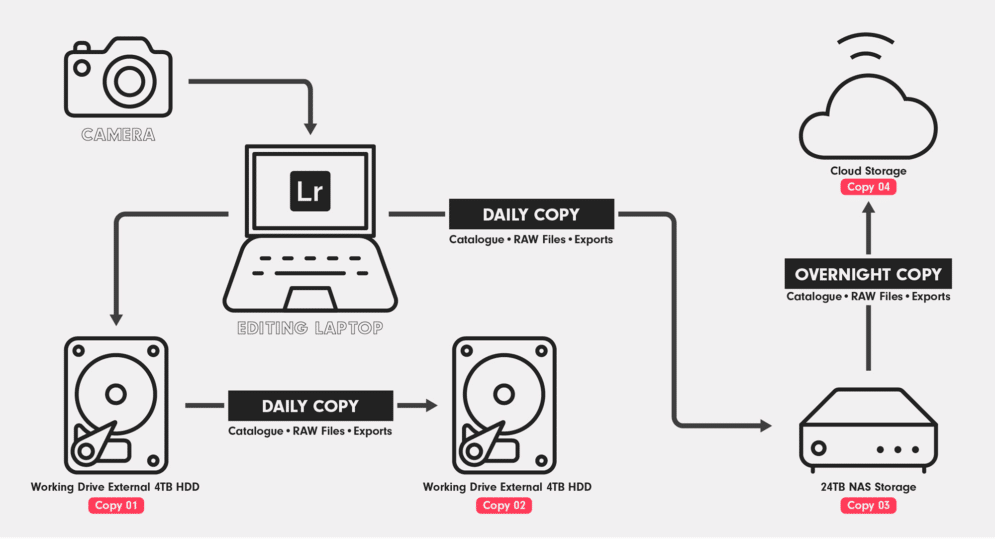For many people, photographs are just about the most precious pieces of personal data they have. Whether they’re smudged Polaroids stuffed into a shoebox or grainy high school selfies, they represent so much more; every frame a painting of a life worth remembering. Given their loss bring can bring great heartbreak, they demand our attention and protection. We back them up, send them to the cloud and try to preserve them.
But not everything goes according to plan. Sometimes data is destroyed or lost despite our best efforts. The loss of personal photos stings. Losing a client’s photos is a sharper loss. San Diego based photographer Joy Portinga experienced that feeling when her hard drive failed. The recovery of her data was a grueling process and a powerful reminder of what’s at stake when that data is lost. The information was eventually recovered, but it would never be the same.
A physical failure, an emotional toll
Portinga recently launched a full-time photography business and invested in a non-Western Digital, consumer-grade HDD to support her operations. After returning from a family trip, she dug out her drive to sort through the photos. Her computer, however, would not detect her hard drive.
After trying different cables and computers permutations, nerves turned to dread as her triage failed to rescue photos from the drive. Eventually, the drive’s physical failure became fatal.
“Things just got worse from there,” Portinga said. After realizing she had lost access to her only backup source – a cloud account – she knew she had to send the drive back to the manufacturer overseas in hopes they could recover her data.
“They were very cryptic and wouldn’t really tell me when I’d get updates. They wouldn’t even tell me when I’d get my drive back,” Portinga said, recalling the limbo state she was left in.
Data life support and recovery
Not all recovery efforts are the same, and there’s a wealth of techniques and software that can be employed to repair and recover data. The best tools often depend on the causes of the problem, cyberattacks require a different approach than a physical failure in the hard drive. Generally, though, there is a four-step process.
First, a technician repairs the original device. Whether that means repairing a component within or working with the engineering of the device to fix internal errors, the original hard drive must return to a semi working capacity. After that the drive is imaged, or copied, to another drive. This prevents further failures from jeopardizing the data.
After the drive is imaged, the logical recovery of the files can begin. This is the grueling work of digging through bits and finding the lost or corrupted file and restoring them so that all the data can be retrieved. Once the data is all accounted for, the repairs can begin.
As Maureen Klatt, vice president of product quality and reliability at Western Digital, sees it, the recovery process is truly a collective effort. While Western Digital’s QA team has its own proprietary tools and software, the company also works with other organizations to save as much user data as possible.
“Our QA team has written tools and scripts to do some of this recovery,” Klatt said in an interview conducted via email. “Sometimes the primary interface (SAS, SATA) can still be used … sometimes they can utilize the SIO port, but if the heads or platters have significant failures, they have in the past sent individual drives to third parties who do heroic data recovery.”
Despite the overall low failure rate of HDDs and the plethora of options that exist for repairing, full recovery is never a guarantee. Some files are still lost forever, and even some that do come back may be altered permanently.
Picking up the pieces
After three nerve-wracking months, Portinga got her hard drive back, but not without some causalities. Not all of her photos had been recovered, and some were irreparably damaged. The corrupted files wouldn’t open in a photo editor, resisting any change beyond the state they were restored to.
Incomplete records aside, Portinga was relieved to find most of her data right where she left it, more or less. Looking forward, Portinga feels a new sense of commitment to securing her data.
“I have a stronger sense of gravity for the work I do,” she said, “as a photographer, I am documenting lives, the little moments, and it’s so precious to get them back.”

Deeper than data
Surviving her data nightmare, Portinga now employs a three-point back up system and follows a strict workflow that protects her data. While shoring up her own habits are important, her story reinforces the importance of reliable storage. Paul Peck, Senior Director of Engineering of HDD Technology at Western Digital, reinforced this sentiment in an email interview.
“Digital content has evolved to encompass almost every aspect of our lives,” he said. “Given the criticality of the information, reliable and stable storage is absolutely vital. We take quality very seriously.”



